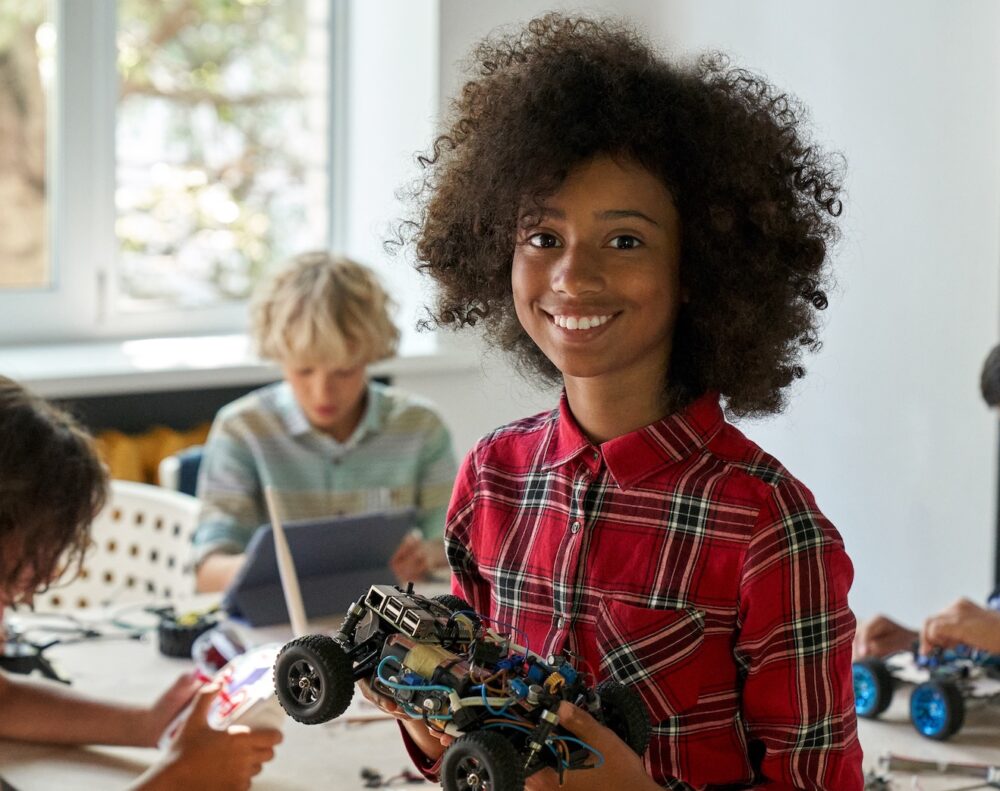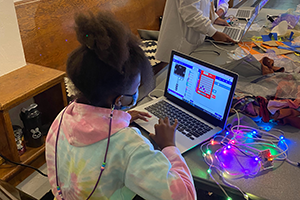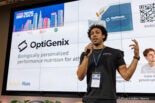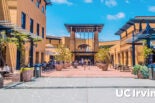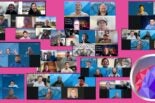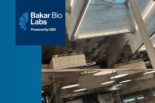By Melissa Weckerle.
Live action role play (LARP) combined with social wearable technology, materials worn on the body that are computationally coded and can support social interactions, provides an impactful social activity for young girls and engages them in the fields of technology and computation.
The Social Wearables Educational Live Action Role Play (SWEL) Camp, funded through an NSF grant awarded to Professor of Computational Media Katherine Isbister’s Social Emotional Technology Lab (SET Lab), was designed by UCSC researchers to blend social experience with computational activities to drive girls’ interest and confidence in pursuing technical subjects.
“There’s a lot of core research around providing girls and women opportunities to solve social problems through technology,” Isbister explained. “There’s more interest in computation if girls are able to craft technology to solve issues that they care about and are relevant to them.”
The camp aims to build an inclusive computational community that is girl-focused and welcoming to those from historically underrepresented communities.
“One of the main design ideas behind the camp is to decrease the distance between introducing a technical concept and making something fun out of it,” said James Fey, computational media Ph.D. student and SET Lab researcher.
The five-day program incorporates elements of design, coding, acting, and the genre of mystery to create a fictional storyline, role-playing format where participants must craft wearable technologies that support social interactions needed to complete a series of tasks and activities.
With the limitations of COVID-19 restrictions over the past two years, SWEL Camp serves as just the right remedy for curbing pandemic fatigue in young students.
Narratives, wearable technologies, and social experiences
The title of the camp’s narrative is “Anywear Academy,” with an emphasis on the word “wear,” as participants have to code and wear the technology they design to complete missions. For example, one segment of the camp challenges students to code their wearables to attain the same color of LED lighting as their team members. Once they do that, they can then move on to the next task.
Over the course of five days, camp participants “travel” to three different worlds: a fairytale world, superhero vs. villain world, and a space world. Each world presents a different storyline with a different set of mysteries to solve.
Students use a combination of wiring tools and basic coding programming languages to fabricate wearable technology. The pieces produced in the past two camps included LED lights and wired material that were worn around the participants’ necks and waists and also acted as costumes, augmenting the immersive LARP experience.
“Students were sculpting their experiences as they went along, becoming the fictional characters and solving problems as a team,” Isbister said.
Students are encouraged to take the materials they design in camp home and are provided various resources to guide them in crafting and coding their own technology once the camp concludes.
The first session of the SWEL camp was held last summer in Berkeley, and the nonprofit organization The Game Academy—which runs LARP classes and camps for kids ages 8–18 to enrich social, emotional, and academic success—was a major contributor to its design as well as its implementation. UCSC researchers began working with Game Academy in 2020 to learn how to blend their social wearable technologies expertise into a LARP setting to create an engaging, fictional narrative for camp participants to experience.
The second session ran in February of this year over two weekends at Digital NEST, bringing together 13 middle school-aged students from local Salinas and Monterey schools.
UCSC plans to run two sessions of SWEL Camp this summer, one in coordination with The Game Academy, and the other on campus through the UC Santa Cruz Educational Partnership Center (EPC) Girls in Engineering program. The EPC oversees the UC Santa Cruz Mathematics, Engineering, Science Achievement (MESA) program, which the researchers worked closely with to secure locations for the camp and recruit girls from other Baskin Engineering-hosted programs, such as Girls in Engineering. Both internal and external partnerships were crucial in the successful running of the first two camps.
Key takeaways and future directions
The camp teaches students a diverse set of soft and hard skills, including group communication, collaboration, problem solving, technical design, coding, and user experience design. It was established to become a use case for other institutions and organizations to adopt and carry out on their own.
Unlike traditional afterschool programs and summer camps that have a single focus, this program has various aspects to it and helps capture a diverse group of students.
“Because this camp casts a wide net of activities, interests, and genres, it’s catching a lot of students that would have otherwise fallen through the cracks from more traditional programming,” Fey said.
The ultimate goal of the NSF-funded project is to “create a sustainable makerspace camp for different institutions and organizations to adopt,” Isbister explained.
After the summer sessions conclude, UCSC researchers are hoping to provide material, best practices, and successful use cases for schools, nonprofits, and other organizations to carry out the program, furthering efforts to bridge the gender and diversity gap in technology and computation.
This article originally appeared in the UC Santa Cruz Newsletter, April 19, 2022, and is re-posted with permission in the UC IT Blog.

